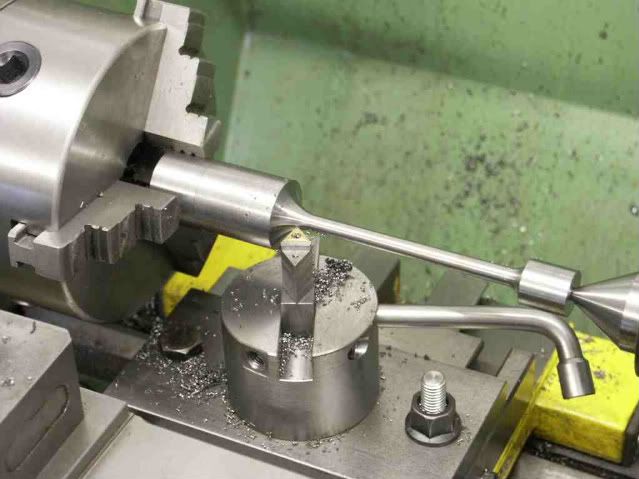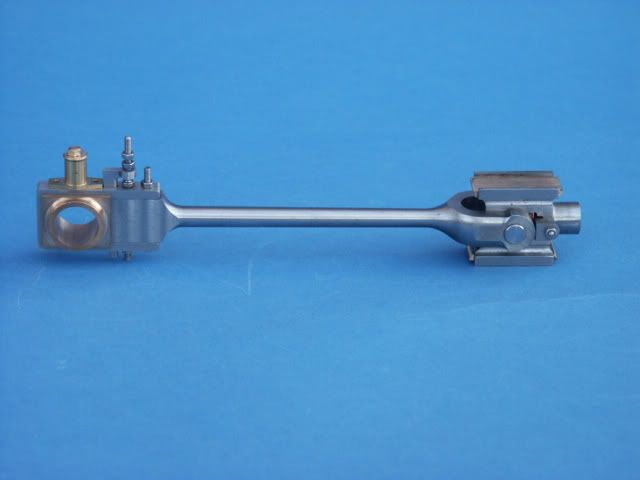Welcome Geo-
I started looking at all the various Stuart engine types the other day, trying to figure out how many different models were made.
The more I looked, the more types I found (some apparently discontinued).
Here is my list (this list may or may not be accurate).
So what type of Launch engine do you have?
Bore, stroke, compound, or simple?
------------------------------------------------------------------------------
Vertical A-Frame style Engines
(all with cylindrical crosshead and Stephenson's reverse gear or reverse gear option)
Cygnet
Vertical A-Frame Single
bore: 2.25", stroke: 2"
(Discontinued?)
Swan
Vertical A-frame Twin (looks like two Cygnets)
bore: 2.25", stroke: 2"
(Discontinued?)
No. 5A
Vertical A-Frame Single (looks like a Cygnet, but without the accessories)
bore: 2.25", stroke: 2"
[ame]http://www.youtube.com/watch?v=eJXxFX9GLyg[/ame]
(Discontinued?)
No. 4
Vertical A-Frame Single
bore: 1.5", stroke: 1.25", flywheel: 5"
http://www.stuartmodels.com/inprod_det.cfm/section/casting/mod_id/65
No. 7A
Vertical A-Frame Single
bore: 1", stroke: 1", flywheel: 3.5"
http://www.stuartmodels.com/inprod_det.cfm/section/casting/mod_id/50
No. 10V
Vertical A-Frame Single
bore; 0.75", stroke: 0.75", flywheel: 3"
(Discontinued?)
No. D10
Vertical A-Frame Twin Engine (Looks like a slightly smaller twin version of the 7A)
bore: 0.75", stroke: 0.75", flywheel: 1.625"
http://www.stuartmodels.com/inprod_det.cfm/section/machined/mod_id/27
------------------------------------------------------------------------------
Horizontal Engines
Mill Engine (Horizontal Single)
Loco crosshead, valve on side of cylinder, long stroke.
bore: 0.625", stroke: 1.25"
(Discontinued?)
Victoria (Horizontal Single)
Loco crosshead, valve on top of cyinder, long stroke.
bore: 1", stroke: 2"
http://www.stuartmodels.com/inprod_det.cfm/section/casting/mod_id/46
Victorian Twin (Horizontal Twin)
Loco crosshead, valve on top of cyinder, long stroke.
bore: 2x1", stroke: 2"
http://www.stuartmodels.com/inprod_det.cfm/section/casting/mod_id/47
No. 9 (Horizontal Single)
Slipper-type crosshead, valve on top of cylinder, short stroke.
bore: 1.5", stroke: 1.5", flywheel: 5.125"
http://www.stuartmodels.com/inprod_det.cfm/section/casting/mod_id/49
No. 8 (Horizontal Single)
Cylindrical crosshead, valve on side of cylinder, short stroke.
bore: 1", stroke: 1"
http://www.stuartmodels.com/inprod_det.cfm/section/casting/mod_id/66
No. 10H (Horizontal Single)
Cylindrical crosshead, valve on side of cylinder, short stroke.
bore: 0.75", stroke: 0.75", flywheel: 3"
http://www.stuartmodels.com/inprod_det.cfm/section/machined/mod_id/28
Score (Horizontal Twin)
Looks like two No.10H's.
Cylindrical crosshead, valve on side of cylinder, short stroke.
bore: 2x0.75", stroke: 0.75", flywheel: 3"
http://www.stuartmodels.com/inprod_det.cfm/section/casting/mod_id/42
------------------------------------------------------------------------------
Open Column Marine Engines (all with Stephenson's reverse gear or option)
Twin Launch (Open Column Twin Launch - Single Expansion)
bore: 2x1", stroke: 1", flywheel: ?
(Discontinued?)
Twin Launch Compound (Open Column Twin Launch - Double Expansion)
bore: 0.75" and 1.25", stroke: 1", flywheel ?
(Discontinued?)
No. 3 (Open Column Twin Launch - Single Expansion)
http://www.stationroadsteam.co.uk/Stuart/No.3.htm
bore: 2x2.5" (single expansion configuration)
stroke: 1.5"
(Discontinued?)
No. 3 (Open Column Twin Launch - Double Expansion)
http://www.stationroadsteam.co.uk/Stuart/No.3.htm
bore: 1.5" and 2.25" (compound configuration)
stroke: 1.5"
(Discontinued?)
Triple-Expansion (Open Column Triple Launch - Triple Expansion)
Vertical Marine-Style Open-Column Engine
bores: 0.75", 1.25" and 1.75", stroke: 1", flywheel: 2.25"
http://www.stuartmodels.com/inprod_det.cfm/section/casting/mod_id/70
Double-Expansion (Open Column Twin Launch - Double Expansion)
While it does not appear on the regular Stuart website, a google search reveals a
No. 6A compound twin marine engine, bores 2.5" and 4", stroke 3".
http://www.stuartmodels.com/inprod_det.cfm/section/casting/mod_id/57
I don't know if this engine is still available or not.
------------------------------------------------------------------------------
Beam Engines
Beam Engine
bore: 1", stroke: 2"
http://www.stuartmodels.com/inprod_det.cfm/section/casting/mod_id/43
Half-Beam Engine
bore: 1", stroke: 2"
http://www.stuartmodels.com/inprod_det.cfm/section/casting/mod_id/45
Major Beam Engine
bore: 1.75", stroke: 3.75"
(This was the best looking of the beam engines.)
(Discontinued?)
------------------------------------------------------------------------------
Oscillator Type Engines
Stuart has a variety of small oscillators (not listed here).
------------------------------------------------------------------------------
Special Type Engines
No.1
A vertical, single-cylinder, open-column engine.
In my opinion, this was the best looking Stuart ever made.
(Discontinued?)
[ame]http://www.youtube.com/watch?v=mD4ci-GHrPo[/ame]
Sirius (Vertical Twin, Single-Acting, Enclosed)
bore: 1", stroke: 1"
This is a slick little Westinghouse-style engine, used to power a small genset during the war.
http://www.stationroadsteam.co.uk/Stuart/sirius.htm
Sun (Vertical Twin, Single-Acting, Enclosed)
bore: 0.75", stroke: 0.75"
James Coombes (Table Engine)
http://www.stuartmodels.com/inprod_det.cfm/section/casting/mod_id/48
800 Gas Engine
Real (Inverted Engine) (Inverted is my term)
4-leg open column engine, top mounted flywheel
bore: 1", stroke: 2"
Williams (Inverted Engine) (Inverted is my term)
Single column engine, top mounted flywheel
bore: 0.625", stroke: 1.125"
------------------------------------------------------------------------------









![DreamPlan Home Design and Landscaping Software Free for Windows [PC Download]](https://m.media-amazon.com/images/I/51kvZH2dVLL._SL500_.jpg)















































































